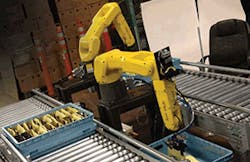Deliver the Goods: How Automated Picking Solutions Help DCs Meet Consumer Demand
The popularity of e-commerce buying is exploding, and the phenomenon has huge implications for shippers and distributors. To paraphrase Charles Darwin, those companies best prepared to adapt to this new reality are the ones that will flourish while laggards will be left in the dust.
The U.S. Census Bureau's recent E-commerce Multi-sector E-Stats report, released in May 2015, notes the industry's steady rise. According to the report, e-commerce sales for U.S. retailers were $261 billion in 2013, up 13.6% from $229 billion in 2012.
And in the 2015 first quarter E-commerce Sales report released by the U.S. Department of Commerce, the Census Bureau reveals that U.S. retail e-commerce sales for the first quarter of 2015 totaled $80.3 billion. E-commerce sales in the retail sector during this period increased 14.5% from the first quarter of 2014.
The rising popularity of e-commerce sales, then, has been a key driver in the continuous advancement of goods-to-person technologies at distribution centers (DCs). In order to execute the quick turnaround time that consumers demand, picking must go off without a hitch. If a carton is lost for hours or picked incorrectly, delays could damage customer relationships.
Receiving incorrect items back into the operation is a financially costly endeavor. Processing returns and returning to stock consume both time and labor resources.
With thousands of SKUs, plus a large variety of packaging styles, the task of fulfilling orders accurately and efficiently is challenging, to say the least. When it comes to order fulfillment, goods-to-person systems are incredibly accurate, with one of the highest picking accuracy rates industry wide. Technology keeps users apprised of what the equipment is picking throughout the entire process, and users can adjust controls to further improve picking precision.
Goods-to-person technology also can improve picking efficiency, as the software in some solutions features advanced algorithms that manage and direct complex piece-picking functionality, enabling batch-picking optimization. With this capability, the system can create batches of identical or similar orders, facilitating a faster rate of speed for order fulfillment. Using batch-picking optimization can further increase the amount of orders processed per hour.
Retail giant Amazon is among those companies reaping the benefits of goods-to-person technology. Amazon has invested heavily in its fleet of Kiva robots—dubbed bots, which collect "pods" or shelves containing merchandise for orders and present them to human employees, who then handle the final selection and packing. The bots then return the pod to a location in the storage zone.
Amazon has installed 15,000 robots in 10 of its U.S. warehouses, and has already seen significant results. The machines aid the online retail giant in seamlessly delivering millions of items to its rapidly expanding customer base. According to a 2014 CNET Magazine article, Amazon's bots have eliminated more than an hour of time spent on an average order.
The use of automated goods-to-person systems is growing steadily. Obvious benefits include the ability to work faster and tirelessly under strenuous conditions.
And there are benefits that may not immediately come to mind when thinking about goods-to-person solutions. The increasing use of robots has generated some concern that automated equipment and robots will cause an undesired reduction in the workforce, "stealing" jobs from human employees. But these machines have demonstrated a strikingly different trend toward reducing employee turnover and improving employees' quality of life on the job site.
Robot Army of Pickers
Advances in picking technology are paving the way for even more impressive production numbers. One of the most prevalent current trends in the area of automated picking systems removes human beings from the equation completely. In goods-to-robot systems, robots select items and in some cases, pack goods for shipping.
Robots are ideally suited for these types of repetitive tasks, especially when the items being picked are easily distinguishable by the vision system. The existing workforce, intimately familiar with quality and production requirements, can transition into a role where employees monitor and operate robot cells, and assist with tricky picks that can prove problematic for the robot pickers. Additionally, management can solicit ideas on utilizing the technology from workers—raising their value to the organization.
Goods-to-person systems go a long way toward alleviating employee fatigue as well.
Historically, management has tasked workers with memorizing product storage locations and maintaining a pace that kept order fulfillment rates at a desired maximum level. The stress of these responsibilities can easily burn out employees, which harm DC productivity and uptime. With the advent of goods-to-robot systems, DC productivity will increase even more.
Robots can also promote a safer work environment for their human counterparts. In the aforementioned scenario, feeling the pressure of meeting production speed criteria, some workers tend to rush across the DC at a frenetic, uncontrolled pace—raising the chances for workplace injuries. When a robot handles the legwork portion of the picking tasks, however, employees can devote more attention to performing quality checks and fulfilling complex orders that robots cannot handle—ultimately benefitting the organization in the end.
The advances in technology required to take goods-to-robot picking to the next level have already been made. Advances in 3-D perception coupled with state-of-the-art robotic end effectors with the ability to pick a variety of shapes and product densities are quickly advancing the development of goods-to-robot technology. In the infancy of goods-to-robot technology, it is likely that many companies will pair goods-to-robot solutions with goods-to-person systems to create a hybrid model.
Distribution center management can rest assured in the knowledge that as e-commerce accelerates, order fulfillment technologies also are advancing. The smartest organizations recognizing these changes are the ones that will deliver superior levels of accuracy and efficiency—and survive.
Brigitte Brozenec is executive vice president at Wynright Corp., a wholly-owned subsidiary of Daifuku North America and a U.S.-based provider of intelligent material handling systems. With more than 200 engineers in-house, Wynright designs, manufactures, integrates and installs a full spectrum of intralogistics solutions, offering both Wynright-branded and third-party equipment.

